This week, as we celebrate Earth Day on April 22, Jenner & Block's Environmental and Workplace Health and Safety Law Practice will be focusing, each day, on a different aspect of the environment and how this year will affect our planet. I thought I would begin our week-long focus on Earth Day with a more personal reflection.
This past pandemic year on Earth gave me a chance to spend more time reading and lots more time thinking about our society and how we communicate with each other. Purely by coincidence, I had a chance to read two pieces of fiction that focus on both the environment and communication. In Richard Powers's Pulitzer Prize winning, "The Overstory," we learn about trees' ability to communicate with each other as part of their survival network. The female scientist who makes this discovery in "The Overstory" calls to mind the work of Dr. Suzanne Simard, a professor of in the Department of Forest and Conservation Sciences at the University of British Columbia, who demonstrated how trees, even of different species, communicate and support each other through underground networks of fungi, known as mycorrhizal networks. The need to communicate, to support each other, to have deep, underground roots is central to all living things. Our ability to communicate as humans starts and ends with our planet.
A complementary novel to "The Overstory" is "A Children's Bible" by Lydia Millet. Millet's dystopian view of our planet's future also has an understory about each generation's inability to communicate their perspectives about their roles in taking care of each other and society. In my reading of "Children's Bible," the ultimate collapse occurs not just because of an environmental disaster, but because the generations stopped being able to communicate with and rely on each other.
Using one of our most useful forms of communication—humor, our first Earth Day cartoonist, Walt Kelly, tied together the need for both protection and connection in an elegant and powerful drawing:

We are all like trees in a giant forest called Earth. We have tentacles and roots touching each other in ways we cannot see, and we cannot continue living if we fail to acknowledge these connections. As we care for each other, we are also caring for our common home. As we communicate with each other, we must remember that we are connected to each other in ways that science is continuing to discover and that our personal experience is still learning.
As with many yearly events, Earth Day gives us an opportunity to reflect, discuss, and share. Thank you for letting me have the opportunity to connect with you.
The content of this article is intended to provide a general guide to the subject matter. Specialist advice should be sought about your specific circumstances.
